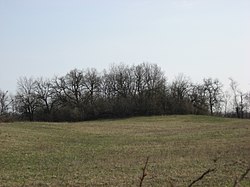|
Mann Mound
The Mann Mound is a Native American mound in the southwestern part of the U.S. state of Ohio. Located near the unincorporated community of Jacksonburg in Butler County,[1] it is tree-covered and sits on the edge of a field[4] in Section 12 of Wayne Township. Its height is approximately 20 feet (6.1 m), and its circumference is approximately 540 feet (160 m).[2] In November 1868, the mound was quarried for gravel by local residents; this excavation continued until the miners had reached the center of the mound, where they found multiple limestone burial vaults. These vaults were built as squares, 3 feet (0.91 m) on each side; each contained a skeleton that had presumably been placed in a seated position. The vaults were stacked from the mound's floor to a position just underneath its summit; each was separated from others by a small amount of gravel. Eight skeletons were removed from these vaults and sent to the Smithsonian Institution.[2] Findings from the mound have led to the conclusion that it is a work of the Adena culture.[1] Despite the damage done by the amateur excavation, the Mann Mound is still a significant archaeological site and the second largest extant mound in Butler County. It was recorded by an archaeological survey published by J.P. MacLean in 1879,[4] and in 1971, it was recognized for its archaeological significance when it was listed on the National Register of Historic Places.[1] References
|
||||||||||||||||||||||
Portal di Ensiklopedia Dunia



